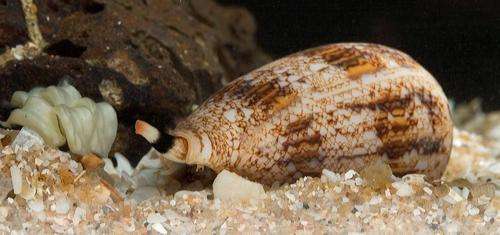Advance toward developing an oral pain reliever derived from debilitating snail venom

Scientists reported today they have created at least five new experimental substances—based on a tiny protein found in cone snail venom—that could someday lead to the development of safe and effective oral medications for treatment of chronic nerve pain. They say the substances could potentially be stronger than morphine, with fewer side effects and lower risk of abuse.
"This is an important incremental step that could serve as the blueprint for the development of a whole new class of drugs capable of relieving one of the most severe forms of chronic pain that is currently very difficult to treat," said David Craik, Ph.D., who led the study.
His presentation is one of more than 10,000 scheduled to occur at the 247th National Meeting & Exposition of the American Chemical Society (ACS).
Craik, who is at the University of Queensland, explained that acute pain occurs when the nervous system is stimulated by a wound or injury and naturally subsides over time. In contrast, chronic neuropathic pain kicks in when the nervous system itself is damaged. This type of pain—which is often triggered by diabetes, multiple sclerosis and other diseases—can last for months, years or even decades. Current treatments for chronic neuropathic pain have serious side effects and provide relief to only about one in every three patients, he said.
One possible solution that Craik and his colleagues are investigating comes from an unlikely source, the cone snail. Cone snails are marine animals that use venom to paralyze their prey. This venom contains hundreds of peptides (small proteins) known as conotoxins. But in humans, Craik says some of these conotoxins appear to have analgesic effects. So far, however, only one conotoxin-derived medication has been approved for human use. This drug, ziconotide, has one big drawback: It has to be infused directly into the lower part of the spinal cord—a clearly invasive procedure.
The team is working to develop a conotoxin-based drug that can be taken orally, which would be much more practical for patients. In previous research, they found a way to modify conotoxin peptides so they formed circular chains of amino acids. As a result, the modified peptides—which are essentially tied into a loop—are extremely stable and resistant to enzymes in the body.
In laboratory rats, a common stand-in for humans in many experiments, a single, small oral dose of a prototype drug based on one of these looped conotoxins appeared to significantly reduce pain, as measured by a standard protocol. Based on this research, the scientists concluded that this prototype drug was about 100 times more potent than morphine or gabapentin, the two drugs that are considered the "gold standard" treatments for chronic nerve pain.
Addiction is less of a concern, Craik said, because conotoxins act on different receptors in the brain than morphine and other opiate drugs.
"We don't know about side effects yet, as it hasn't been tested in humans. But we think it would be safe," Craik said. "It acts by a completely different mechanism than morphine so we think it has a minimal possibility of producing the side effects of that medication. That is one of the big advantages of this drug."
Craik's team also has developed at least five additional new substances based on the looped conotoxin prototype drug. They are currently evaluating the therapeutic potential of these new substances, which they developed by tweaking the composition of the amino acids in the prototype conotoxin drug used in their initial animal studies. They are also seeking funding and approval for human studies. Craik says it will likely be at least two years before such studies begin.
More information: Abstract
Peptides derived from the venoms of marine cone snails have attracted recent attention as potential therapeutic agents for the treatment of chronic pain. These conotoxins are 12-40 amino acids in size and are typically stabilized by two or more disulfide bonds. Although conotoxins share the attractive features of peptides in general of having exquisite selectivity and potency for specific ion channels, membrane receptors or transporters, they also share the general disadvantages of peptides of short biological half-lives and poor oral bioavailability. Cyclization has been used in the past as a strategy in the pharmaceutical industry for stabilizing and locking the conformation of small peptides of 5-12 amino acids. This cyclization strategy can also be applied to conotoxins to produce additional stabilization, with the potential to dramatically increase the therapeutic potential of these molecules. In this study, we describe the development of a cyclic conotoxin analogue that has potent analgesic activity in the chronic constriction injury model of neuropathic pain in rats when administered orally. This result demonstrates the effectiveness of the cyclisation approach for the stabilization of peptide therapeutics. The cyclization approach has been successfully applied to a range of conotoxins, highlighting its broad potential in drug design.
Provided by American Chemical Society
















